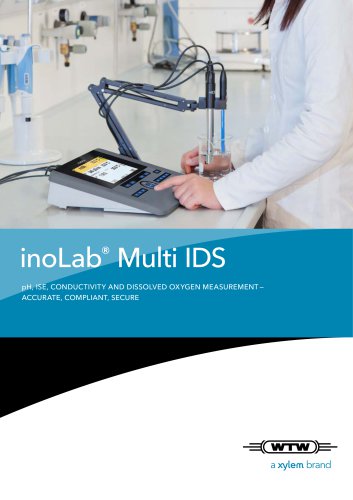
Catalog excerpts

Visco handbook THEORY AND APPLICATION OF VISCOMETRY WITH GLASS CAPILLARY VISCOMETERS
Open the catalog to page 1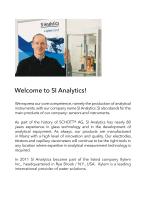
Welcome to SI Analytics! We express our core competence, namely the production of analytical instruments, with our company name SI Analytics. SI also stands for the main products of our company: sensors and instruments. As part of the history of SCHOTT® AG, SI Analytics has nearly 80 years experience in glass technology and in the development of analytical equipment. As always, our products are manufactured in Mainz with a high level of innovation and quality. Our electrodes, titrators and capillary viscometers will continue to be the right tools in any location where expertise in...
Open the catalog to page 2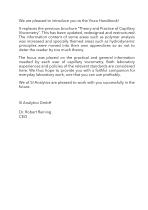
We are pleased to introduce you to the Visco Handbook! It replaces the previous brochure "Theory and Practice of Capillary Viscometry". This has been updated, redesigned and restructured. The information content of some areas such as polymer analysis was increased and specially themed areas such as hydrodynamic principles were moved into their own appendices so as not to deter the reader by too much theory. The focus was placed on the practical and general information needed by each user of capillary viscometry. Both laboratory experiences and policies of the relevant standards are...
Open the catalog to page 3
Appendix A Symbols and units us
Open the catalog to page 5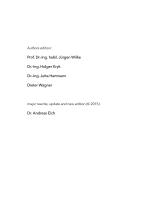
Authors edition: Prof. Dr.-Ing. habil. Jürgen Wilke Dr.-Ing. Holger Kryk Dr.-Ing. Jutta Hartmann Dieter Wagner major rewrite, update and new edition (© 2015):
Open the catalog to page 6
CHAPTER 1 VISCOSITY - RHEOLOGY 1.1 Introduction The subject of this Visco Handbook is viscometry with glass capillary viscometers. Viscometry deals with the determination of viscosity and is a branch of rheology, which is scientifically concerned with the flow and deformation behavior of materials. In rheology, substances, especially viscoelastic ("semi-solid"), are examined, which are classified as being between a fluid and a solid, based on their mechanical properties. With glass capillary viscometers, only the viscosity of samples with ideal flow behavior (Newtonian liquids) is measured....
Open the catalog to page 7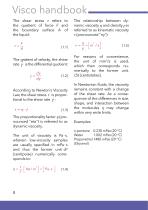
Visco handbook The shear stress τ refers to the quotient of force F and the boundary surface A of the liquid: τ = The gratient of velocity, the shear rate γ is the differential quotient: According to Newton's Viscosity Law, the shear stress τ is proportional to the shear rate γ : The proportionality factor η (pronounced "eta") is referred to as dynamic viscosity. The unit of viscosity is Pa · s, wherein low-viscosity samples are usually specified in mPa s · and thus the former unit cP (centipoise) numerically corresponds to: η= The relationship between dynamic viscosity η and...
Open the catalog to page 8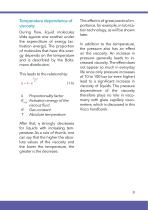
Temperature dependence of viscosity During flow, liquid molecules slide against one another under the expenditure of energy (activation energy). The proportion of molecules that have this energy depends on the temperature and is described by the Boltzmann distribution. This leads to the relationship: _ Evisk i RT k Proportionality factor Evjsk Activation energy of the viscous fluid R Gas constant T Absolute temperature After that, n strongly decreases for liquids with increasing temperature. As a rule of thumb, one can say that the higher the absolute values of the viscosity and the...
Open the catalog to page 9
Viscosity of mixtures/solutions When liquids are mixed, the viscosity can be approximately calculated from the viscosities of the individual components according to a logarithmic mixing rule. Example of two components: InVmix = w ilnni + w2lnn2(1.7) wv w2: weight fractions of the components 1,2 This rule only applies to mixtures of similar components, and does not generally apply for aqueous solutions. For a better description of reality, equations must be selected with adjustable parameters [2]. The viscosity of the solutions of solid substances is often higher than that of the pure...
Open the catalog to page 10
1.2 Non-Newtonian flow behavior Shear thickening (dilatancy) Shear viscosity increases with rising shear rate (work hardening: Fig. 2, Curve b). a - newtonian fluid b - shear thickening c - shear thinning Fig. 2 Viskosity curves of fluids Shear thinning (pseudoplasticity) Examples: - Lacquer/varnish - Thermoplastics - Polymer melts - Adhesives - Additives - Emulsions - Suspensions Yielding point (plasticity) The liquids only begin to flow at a minimum shear strain. Below this yielding point, the substance behaves as a solid. Examples: - Paints, dispensions, cream - Food (mayonnaise) -...
Open the catalog to page 11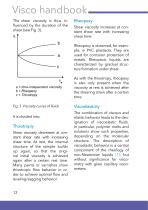
Visco handbook The shear viscosity is thus influenced by the duration of the shear (see Fig. 3). η b a c ts a = time-independent viscosity b = Rheopexy c = Thixotropy Fig. 3 Viscosity curves of fluids Thixotropiy Shear viscosity decreases at constant shear rate with increasing shear time. At rest, the internal structure of the sample builds up again, so that the original initial viscosity is achieved again after a certain rest time. Many paints or varnishes show thixotropic flow behavior in order to achieve optimal flow and leveling/sagging behavior. 12 Rheopexy Shear viscosity increases...
Open the catalog to page 12
1.3 Principles of viscosity measurement Rheological measurement procedures are mainly using mechanical methods, since they are based on the mechanical quantities stress and strain of the sample. Viscosity measurement instruments usually generate a defined shear deformation (shear) and measure the required shea stress, or vice versa. The ratio of the two variables is, according to Eq. 1.3 the viscosity. The most important possibilities for the realization of the deformation of the sample is shown in Fig. 4. Perfection in manufacturing and sophisticated quality-assurance methods form the...
Open the catalog to page 13
Visco handbook CHAPTER 2 FUNDAMENTALS OF BASICS OF CAPILLARY CAPILLARY VISCOMETRY VISCOMETRY 2.1 Measurement principle Inside the capillary viscometers, the velocity gradient required for viscosity measurement is built up in the form of a laminar tube flow within a measurement capillary. Under idealized conditions, • laminar, isothermal, steady flow condition • Newtonian flow behavior of the liquid • pressure independence of the viscosity • incompressibility of the liquid • wall adherence of the liquid • neglect of the flow influences at the entry and exit of capillary of sufficient length...
Open the catalog to page 14All Xylem Analytics Germany Sales GmbH & Co. KG. catalogs and technical brochures
-
The system 282/284
8 Pages
-
ProfiLine Handhelds
8 Pages
-
IQ Sensor Net
20 Pages
-
inoLab® Multi IDS
8 Pages
-
inoLab® 7000 Series
8 Pages
-
Drinking Water Monitoring
8 Pages
-
OPTi® Food & Beverage
2 Pages
-
OPTi® Beer & Wine
2 Pages
-
OPTi® Automotive
2 Pages
-
Flow-through Refractometry
4 Pages
-
Bellingham + Stanley
8 Pages
-
ADP600 Series Polarimeters
6 Pages
-
Room Climate Monitor RM 100
4 Pages
-
HACCP never was as easy
8 Pages
Archived catalogs
-
Viscometry Catalog
35 Pages
-
The new CHEMfit 340 armature
56 Pages
-
Laboratory Electrodes
5 Pages
-
Titration Catalogue
57 Pages
-
The new titrators and burettes
48 Pages
-
Meters and Electrodes catalog
59 Pages
-
Process Equipment
160 Pages
-
pH handbook
100 Pages







